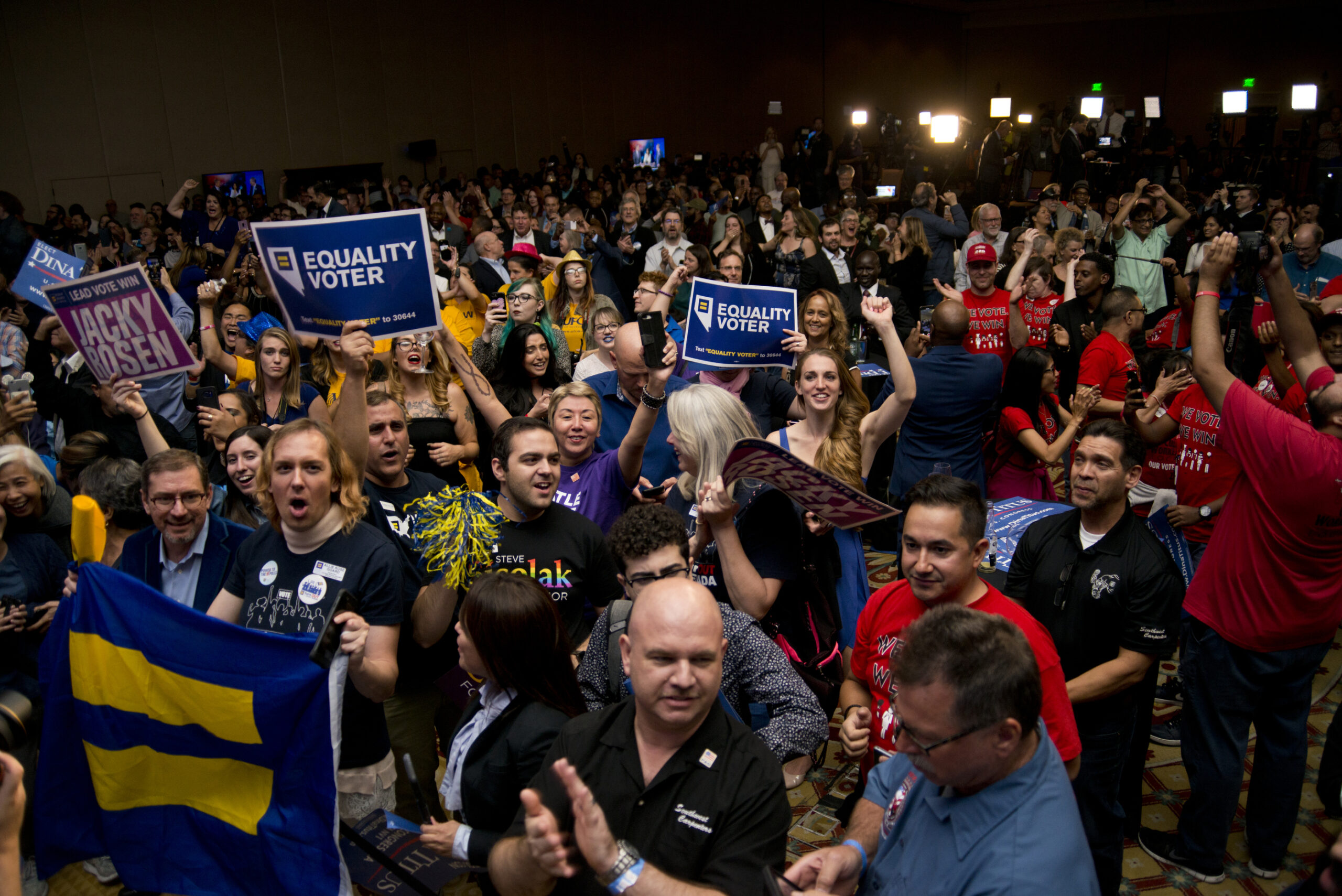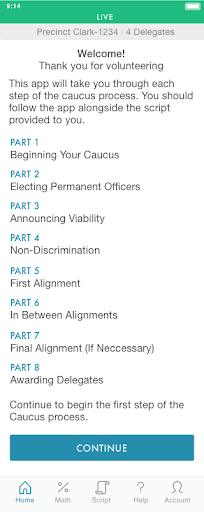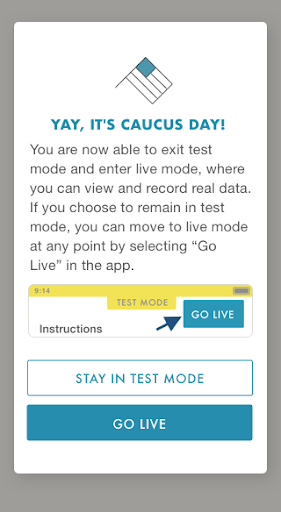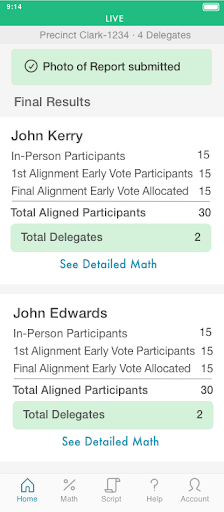Nevada Democrats release details of app-based early voting, caucusing ahead of first-in-the-West contest

Nevada’s Democratic presidential caucus will enter the digital age for the first time in 2020.
For the last year, the state Democratic Party has been developing technology to facilitate its first-in-the-West caucus, which will, in another first, include an early voting option. The apps the party has created aim to seamlessly link the early voting process with the traditional Caucus Day operation, but the addition of early voting and new technology to the process has also ramped up pressure on the party to run a smooth caucus, especially after a fraught caucus-to-convention process in 2016.
Conversations about security have been central in developing the apps, particularly in light of concerns over Russian hacking in the 2016 election and after the Democratic National Committee scrapped the state party’s proposed tele-caucus option earlier this year over security concerns. Party officials, who shared details of the early voting and Caucus Day process with The Nevada Independent this week, did not go into detail about the specific security measures they are putting into place, other than to say that they are implementing “common” protocols, such as two-factor authentication for log-ins to the apps.
“We've been working hand in hand with the DNC and security experts to ensure that this process is going to be secure at every step,” said Shelby Wiltz, the state party’s caucus director. “I think we're really fortunate to have the DNC's support throughout all of this, especially as we do much of this work for the very first time. We've been very supported by them and feel good about the processes we're putting in place to ensure the integrity of the caucuses first and foremost.”
The party is planning to use technology at two steps of the caucus process — during early voting and on Caucus Day. Early voters will be able to use an app downloaded onto party-purchased tablets stationed at early voting sites to cast their presidential preferences, and then those early votes will flow into a separate app that will be used by precinct chairs to run the actual process on Caucus Day.

Creating a system that could connect the early voting process with the Caucus Day operation was important to the party because early voters’ presidential preferences will be transferred to their home precincts to be counted alongside their neighbors’ preferences.
According to the advanced glimpse into the caucus process provided by the party this week, the early voting process will work something like this: For a four-day period in mid-February — the 15th to the 18th — those wishing to participate early in Nevada’s Democratic Caucus will be able to show up to nearly 80 early voting sites across the state, places such local libraries and community centers, high schools and college campuses, and even the Eureka Opera House.
When they show up to an early voting site, participants will be required to check in on a tablet that will verify whether they are a registered Democrat. If they are, they’ll get a green confirmation bar on the screen and will be provided a random PIN to cast their presidential preferences. If they are but are not at an early voting site located in the county where they’re registered, they will get an error message advising them that they need to vote in their home county. If they’re not a registered Democrat or registered at an old address, volunteers at the early vote site will have forms on hand to get them registered and will log that new registration into the system — so the person can’t then go to a different early voting site and try to vote again as a new registrant.
Early voters will be allowed to wear t-shirts and pins in support of their preferred candidate to the early voting sites, but the party has banned all campaigning within 100 feet of its early voting sites and campaigns will be limited to one observer who must stay in an observation area during early voting hours. That differs from the traditional Caucus Day process where campaigns are allowed to have a small number of staff or volunteers on site who may make pitches in support of their candidate during a specific period during the caucus.
Once the participant has been successfully checked in and provided a PIN, they will proceed to a station with a tablet equipped with the early voting app. Party officials say not to expect a booth with curtains — it’ll be more like a designated spot with a tablet at a table with what they describe as a “reasonable amount of privacy.” Once there, they’ll be asked to use their PIN to log in on the tablet. (Party officials say voters won’t be able to enter a random PIN because the numbers only remain active for a short period of time.)
Once logged in, voters will be able to select what language they want to vote in, either English, Spanish or, another new option this year, Tagalog. They will then be offered a list of candidates on the screen and asked to make their first presidential preference. They’ll also be required to make second and third choices and an optional fourth or fifth choice.
Those additional second through fifth preferences could be important when their votes flow back to their home precinct to be counted with their neighbors on Caucus Day. Each candidate needs to reach a certain threshold, typically 15 percent of the caucusgoers at a precinct, to be considered viable. If they don’t hit that threshold, their supporters are offered a chance to realign in support of a different candidate. But because early voters won’t be there in person for the realignment period — and therefore see which candidates made the viability cut — choosing several backup candidates gives voters a chance to ensure that at least once of their candidates meets the threshold.
“We will always respect the first choice of early voters and only realign them when necessary to help make sure that their vote is counted on Caucus Day,” Wiltz said.
She also confirmed that if none of an early voters’ five choices makes the viability cut, they would not be able to be realigned with any candidate on Caucus Day.
As the voters select their choices from the list in the app, those candidates will be moved onto a separate list on the side of the screen that will show their presidential preferences in order. Voters will be able to go back and change their options at any time before submitting their final preferences. After casting their third choice, voters will be offered the option to keep going to add a fourth and fifth choice or stop and submit their preferences. Once voters have finalized their list, they will be taken to a final screen to confirm their preferences. They will also be asked to write down their presidential preferences on a paper form given to them when they checked in — which also has their PIN written on the top — and check a box in the app confirming they have done so. Once they have verified the information is correct, the voter will click a button to submit their preferences and will be done with the early voting process.
“The great part about it is you show up, you record your preferences, and then you're able to go home,” Wiltz said. “It should be a pretty short process compared to the sometimes hours and hours long process you could experience on Caucus Day.”
All early presidential preferences cast will remain secret until Caucus Day. Wiltz said that none of the results will be accessible to anyone, not even party officials.
“No one here at the party will have access to any of the data, and I think that's really important, especially as it pertains to the integrity of the process,” Wiltz said.
Before Caucus Day, precinct chairs responsible for running caucus operations will be required to download a separate but connected app on their Apple or Android phones. To log into the app, they will be required to provide an email or username and password, in addition to their precinct number. They’ll then be prompted to verify their log in either through an authenticator app or via SMS.
Precinct chairs will be able to use the app in test mode before the caucus to get familiar with how it works. The app will also automatically download their precinct’s early vote data to their app at some point before Caucus Day, though that information will not be accessible until the caucus has begun and they’ve reached the appropriate step in the caucus process. The app will also include other features, including a frequently asked questions screen and a tiebreaker function.
On Feb. 22, precinct chairs will get a notification telling them that it is Caucus Day, and the app will automatically activate a “go live” mode at the time the caucus is set to begin. Once the precinct chair clicks the “go live” button, the app will guide them step-by-step through the caucus script.

One of the early steps will ask the precinct chair to count the number of in-person attendees and input them into the app. At that point, the chair will also be able to see the number of people assigned to that precinct who early voted. That overall total — in-person attendees plus early voters — will be used to calculate the viability threshold the candidates must meet. The app will then prompt the precinct chair to click submit to transmit that information to the party.
Then, the app will walk the precinct chair through the first alignment process, which is where the in-person attendees choose which presidential hopeful to back. The app comes with instructions and a 15-minute timer to facilitate the process. Once the in-person attendees have aligned themselves, the precinct chairs will click to another screen where they will enter how many people have aligned in-person in support of each candidate. That screen will also the first time where the precinct chairs will be able to see the results from early voting for their precinct.
As the chair inputs the in-person results, the app will calculate the total of in-person plus early votes and turn the names of the candidates green if they made the viability threshold or red if they did not. The app will also give the chair an error message if the number of in-person votes they have counted is less than or more than the number of in-person attendees they submitted earlier in the process.

Once the chair submits the results of the first alignment, the realignment period will begin, allowing the in-person voters whose candidates did not make the cut to instead choose a candidate that did. When that 15-minute period is up, the precinct chair will be required to input the results of the realignment and, at that point, will also see the results of any auto-realignments that happened based on the second through fifth choices indicated by the early voters. After that, the precinct chair will be taken to a screen that will show the final results, including the final delegate allotments for the precinct, to be submitted electronically to the party.
As a physical backup, precinct chairs will be required to complete paper reporting sheets and caucusgoers will be required to fill out paper presidential preference cards with a unique PIN given to them upon check in, like with the early voting process. Previously, caucusgoers only wrote their names on their presidential preference cards.
In the event of technological difficulties, party chairs will still be able to run their apps offline, provided that they have downloaded their precinct’s data at some point before Caucus Day, either over WiFi or 4G. The party will also have a helpline that can provide early vote totals to precinct chairs — who can do the caucus math and delegate apportionment by hand on paper — and receive results over the phone in the event they’re not able to be transmitted electronically.
Party officials are also planning to visit every early voting and Caucus Day site to prepare for which sites are most likely to have cell service or WiFi issues.
“It's a lot of work,” Wiltz said. “But I think it's worth it because what it means is that we can plan ahead for places where we know we're going to have issues and be able to provide a separate solution for some of our more rural sites or sites that for one reason or another just won't have reliable access to a data source.”
There’s still one major unknown, though — how many people are going to show up, and when. About 118,000 Democrats caucused in Nevada in 2008 and 84,000 in 2016, and party officials don’t have any idea how much letting Democrats cast their presidential preferences early might boost those numbers, particularly because early voting is more popular than Election Day voting during regular elections in Nevada.
“We probably are expecting high turnout in the caucus overall, but this process is brand new, and I think it's a unique year,” Wiltz said. “We can't predict how many folks are going to show up one way versus another way, but we do strongly believe that providing this early vote option is going to expand access to people who otherwise wouldn't have come.”
Updated 12-5-19 at 8:19 a.m. to correct that while the app will be compatible with Apple and Android phones, it won't be available publicly through the app stores. The early vote data will also automatically download to precinct chairs' phones before Caucus Day.
